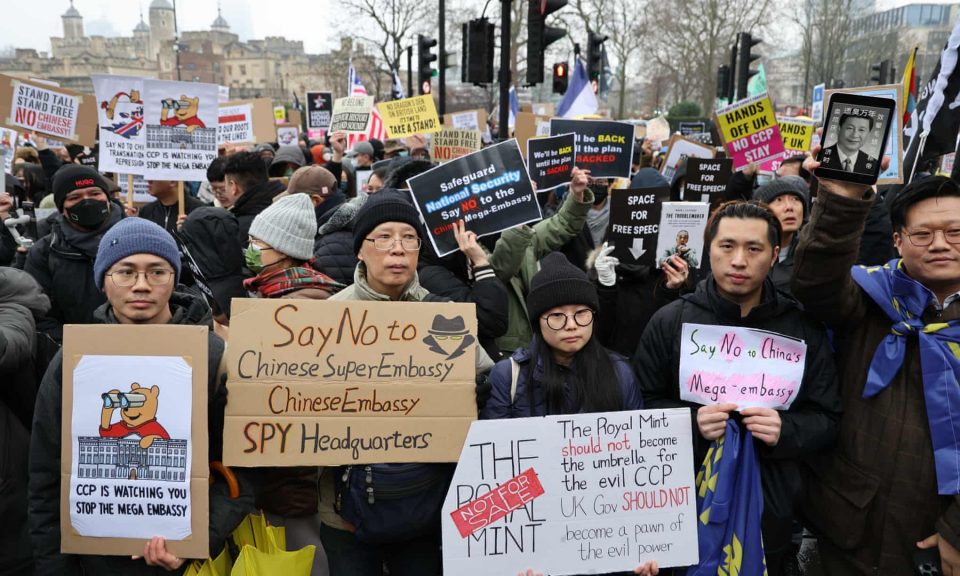On Saturday, a significant number of individuals assembled outside the prospective location for a new Chinese “mega-embassy” in London, where both politicians and protestors voiced their apprehensions about potential uses of the facility to “monitor” dissenters.
Over 1,000 demonstrators gathered at the Royal Mint Court, previously the base of the UK’s coin manufacturer, situated close to the Tower of London. The area is set to be transformed into a Chinese embassy.
China acquired the property and aims to develop the two hectares (five acres) into the largest embassy in Europe.
In 2022, Tower Hamlets council denied planning approval, citing multiple concerns, including the potential for significant protests at the site. The Conservative administration opted not to intervene in the matter.
After the Labour Party gained power, Beijing refiled its application, prompting the government to take notice following a direct conversation between Chinese President Xi Jinping and Keir Starmer. Cabinet members Yvette Cooper and David Lammy indicated their support for the project, with a local inquiry hearing set to commence next week.
The ultimate decision will be made by Angela Rayner, the deputy prime minister and housing secretary.
Protesters, including many refugees from Hong Kong residing in the UK, raised alarms that the embassy could serve as a means to “monitor” and unlawfully detain dissenters.
Tai, a 50-year-old carer, remarked, “We hail from Hong Kong. We fear that China may use this location to supervise and act against us. We have faced numerous instances of the Chinese Communist Party infringing upon the freedoms and democracy of the people of Hong Kong. We are all at risk.”
He raised concerns that the Chinese government might utilize the embassy to “oversee Hong Kong residents living in the UK,” adding, “People flee Hong Kong out of fear of the Communist Party.”
Another protester, identifying herself as Mitochondria, 20, shared similar fears. “It is very likely that this building could be used to detain Chinese dissenters on British soil in an illegal manner,” she stated. “A mega-embassy would facilitate that possibility.”
She waved a blue and white flag representing the Uyghurs and asserted, “The Chinese government has imperialist intentions, occupying the territory of East Turkestan. There is a genocide occurring against the Uyghurs, the Muslim populace in East Turkestan. They deserve to live free from oppression. This is why I hold this flag, as we fight against the same authoritarian regime.”
Midway through the protest, police officers were seen escorting a woman to a van. A substantial group of demonstrators clad in black surrounded the vehicle, chanting “let her go” in an attempt to obstruct its departure.
Another woman appeared to be unwell, laying on the rain-soaked road.
Fred, a 29-year-old engineer, articulated his worries that the embassy would be used to “capture individuals inside and engage in espionage.”
“We stand as a beacon of freedom globally. It is disheartening to witness such a beautiful site, a symbol of our legacy and pride, fall into the hands of a dictatorship.”
Several prominent figures, including Iain Duncan Smith, Tom Tugendhat, and Labour MP Blair McDougall, addressed the protesters as well. Tugendhat, a former security minister, remarked that permitting the embassy to proceed would constitute a “serious error.”
“It would clearly indicate that our government has chosen the wrong side, neglecting the defense and protection of British citizens and our economic future,” he asserted.
He emphasized that allowing the plans to advance would convey a message globally that the British government “has not grasped the lessons of the past decade” and “is not listening.”
Tugendhat explained to reporters: “Some decisions made in 2010 or 2013 can be understood given the context at that time; one can see the optimism with which they were made.
“To maintain that same optimism in 2025? That is no longer optimism; it is outright ignorance.”


